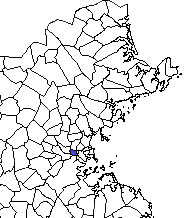
 Location: 2 Common Street, Charlestown
Location: 2 Common Street, Charlestown
Coordinates: 42°22’27.9″N 71°03’35.9″W
Date dedicated: June 17, 1872
Architect/sculptor/manufacturer: Martin Milmore, designer and sculptor
Number of names: None
Martin Milmore designed and sculpted some of the most imposing Civil War monuments in Massachusetts. Charletown’s large statue grouping is among his most noteworthy works. Milmore was born in Sligo, Ireland in 1844. When he was seven, his widowed mother emigrated to Boston and soon after made arrangements for her sons to join her in America. His older brother Joseph became a stonecutter and educated Milmore in that trade. Milmore took it a step further and became a excellent sculptor. By the late 1860s, the two had opened a studio together on Harrison Street in Boston’s South End. His work can be seen in Boston, Fitchburg, Woburn, Framingham,and other locations, including the enigmatic “American Sphinx”—an unusual Civil War memorial at Mount Auburn Cemetery in Cambridge.
Milmore played a significant role in defining the form of Civil War monuments in the Commonwealth. His first war memorial–Roxbury’s monument located in Forest Hills Cemetery–was sculpted in 1867. It was one of the first monuments in Massachusetts to literally place the volunteer soldier on a pedestal. This seems commonplace to us now as we see them in many towns, but this sort of memorialization, prior to the Civil War, had only been reserved for great leaders. With Milmore’s monuments, the common soldier (representing the lost sons and husbands of entire communities) was now enshrined. It would be a while before this caught on. For about a decade after the war, most memorials were architectural in nature–usually an obelisk or some form of column. By the mid 1870s, other sculptors began to design monuments emulating Milmore’s work.
 His Charlestown monument features a soldier and a sailor being crowned with laurel wreaths by a female figure representing “Liberty.” The same sailor sculpture appears on the Fitchburg monument but cast in bronze. The soldier figure, with slightly modified facial features including the addition of a mustache, appears in Fitchburg and Framingham, also cast in bronze.
His Charlestown monument features a soldier and a sailor being crowned with laurel wreaths by a female figure representing “Liberty.” The same sailor sculpture appears on the Fitchburg monument but cast in bronze. The soldier figure, with slightly modified facial features including the addition of a mustache, appears in Fitchburg and Framingham, also cast in bronze.
The dedication of the Charlestown monument in 1872 was accompanied by particularly large celebrations as it took place on “Bunker Hill Day,” the anniversary of the Revolutionary War battle. Bands gave concerts in the town’s three principal squares over the course of the morning. Boat races took place on the Charles River. Richard Frothingham a historian and newspaper editor who was formerly mayor of Charlestown and a representative to the state legislature, gave the dedication oration. His speech was light on contemporary political rhetoric and instead focused primarily on historical themes, tying together the causes for which men of Charlestown fought in the Revolution and the late war–especially republican government.[1]
This connection was indeed embodied by many Charlestown men, perhaps none more so than Lt. Peter Marion Holmes. He lived in a house facing the training green, directly behind the spot where the Soldiers’ and Sailors’ monument would eventually stand. Lt. Holmes greatly admired Dr. Joseph Warren, the famed leader during the Battle of Bunker Hill who died resisting the final British charge and was buried in a mass grave with his men. It was Warren’s example that inspired Holmes to join. While serving with the 36th Massachusetts Infantry in 1863, Lt. Holmes was killed at Campbell’s Station, Tennessee. He was shot resisting a Confederate charge and buried in a mass grave with his men. His loss was keenly felt by his many friends in Charlestown.[2][3]
Click photos to enlarge:
[1] “Proceedings at the Dedication of the Soldiers’ and Sailors’ Monument by the City Council of Charlestown, June 17, 1872,” (Charlestown: Chronicle Office, 1872), 23.
[2] Seth Daniel, “Training Field is a Place Where ‘Never Forget’ Cannot be Ignored,” Charlestown Patriot-Bridge
[3] Bunker Hill Club, “A brief memorial of Lieut. P. Marion Holmes, of 36th regt., Mass. vols,” (Charlestown: Watson’s Press, 1864), 6-7.



